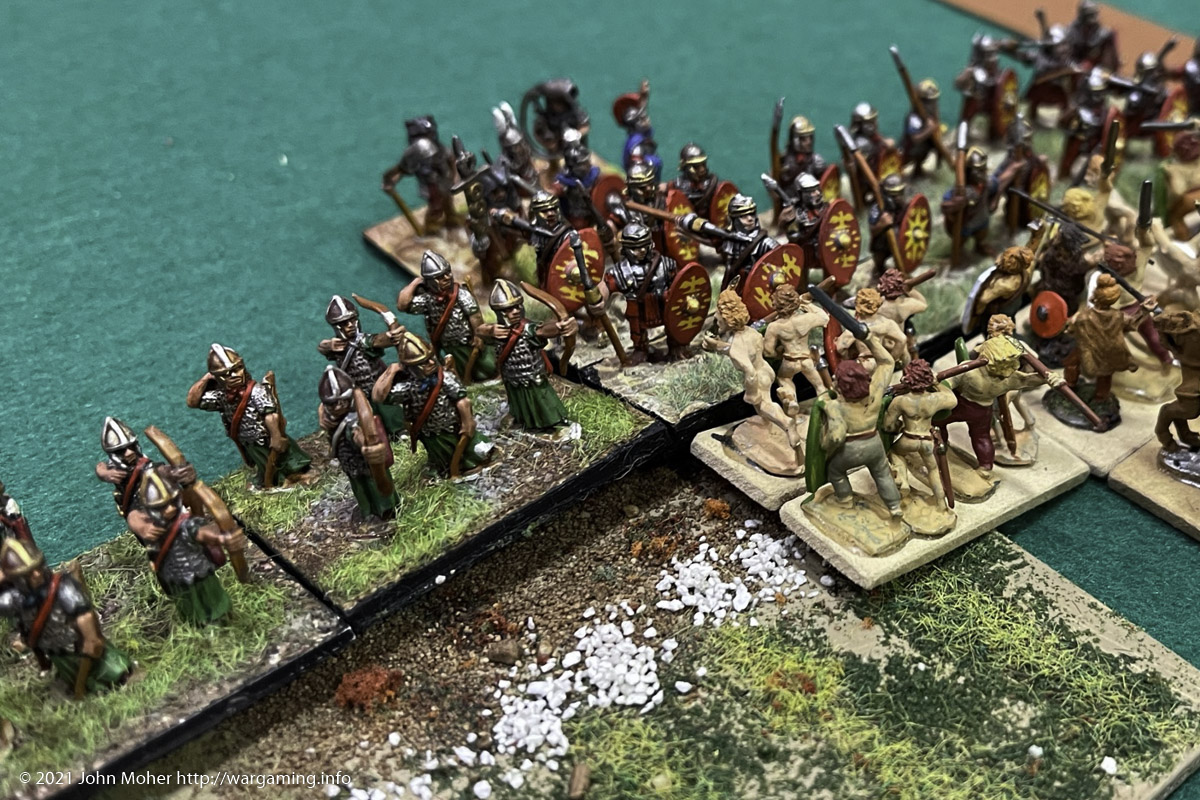Over the long weekend just gone (Queen’s Birthday here in NZ) I was back in my home town of Christchurch and my old local wargaming club there had some members hosting an introduction and training day for Art De La Guerre (ADLG) to coincide with the recent release of Version 4 of the rules. This looked an interesting opportunity to finally try these out and also catch up with several old wargaming comrades from the 1980’s and early 1990’s (most of whom I have not crossed paths with for many years).
Games would be 200 points in size (essentially the smallest size game normally played, and vaguely similar to big battle DBA in army size – more commonly games are 300 points or occasionally 400 points), and the focus would be on basic mechanics, and for those already familiar with ADLG, the rule changes in version 4. The game was played in 15mm and the Early Imperial Romans’ were loaned by Andre (one of the event organisers & host) and my opponent was Gordon with quasi-historical Gallic opposition.

The outcome of the pre-game process was the Romans were invading the Gaul’s, so I chose plains as the terrain type (invaders choice), and once terrain was position and corps (command) positions recorded by each side the invading Romans’ deployed their corps second and moved first. The terrain present were some fields, a gentle hill and a road; and both sides choose to put their mounted forces on the more open flank (the Roman left/Gallic right).

Early Imperial Roman 102 AD (in deployment sequence left to right) Corps III: Decius (competent) 2 Equites Alares (heavy cavalry, elite) 2 Equites Catafractari (heavy cavalry, impact, elite) 2 Equites Sagitarii (light cavalry, bow) Corps II: Germanicus (competent) 6 Legionaries (heavy swordsmen, armour, impact) Corps I: Tiberius (ordinary) 4 Auxilia (medium swordsmen, armour, impact, elite) 2 Auxilia Sagitarii (bowmen, pavise) 1 Auxilia Sagitarii (light infantry, bow) 1 Fortified Camp ARMY SIZE: 20

Gauls (as deployed Roman left to right) General 1 (brilliant?) 4 Cavalry (medium cavalry) 5 Warband (medium swordsmen) General 2 (competent) 6 Gaestati (medium swordsmen, elite) General 3 (competent) 7 Warband (medium swordsmen) 3 Skirmishers (light infantry, sling) ARMY SIZE: 25

The Roman force featured to 2 competent Generals and 1 ordinary, while the Gaul’s had 1 brilliant and 2 competent Generals (if my memory is correct). On the basis of a fast battle (game) is a good battle (game) the Roman force advanced rapidly on the first move, the key purpose being to establish the Auxilia in the fields on the Roman right and tie down the opposing Corps of Gaul’s, while the Equites Alares & Equites Catafractari on the opposite flank endeavoured to overpower the Gallic Cavalry. In the centre the Legions would hold in front of the Gaestati and endeavour to entice them to either (a) have to hold their position (and avoid going impetuous), or (b) initiate combat with the legionaries and charge in.

Meanwhile the light troops (2 Equites Sagitarii with the cavalry on the Roman left, and 1 Auxilia Sagitarii ‘psiloi‘ with the auxilia on the Roman right) would serve to cover the gaps and keep the Gaul’s occupied to prevent them turning the flanks of the legions in the centre. This they did surprisingly well. Meanwhile first blood was drawn by the Roman’s on their left, with the Equites Alares unit on the extreme flank riding over the top of the opposing Gallic Cavalry after about 3 rounds of combat (see image above).

In the centre the Gaestati had charged in, but had had a somewhat underwhelming effect, and damage was being dealt out quid pro quo between them and the legionaries. However despite some rallying by both sides the legionaries slowly gained the upper hand and broke a unit of the Gaestati on the Roman right (see above). Likewise on the Roman right flank the Auxilia & Auxilia Sagitarii had chased off the Gallic Slingers, and successfully held their own against the ‘warband‘. As the Auxilia Sagitarii were swinging around the Gaul’s open flank the right-most Auxilia overpowered the opposing warband unit, further exposing the Gaul’s flank on that side (see below).

By this time things were getting a bit frustrating for Gordon and his Gaul’s, all 3 of his corps had a flank of their main bodies turned, and his superiority in numbers was proving ineffective as his remaining troops were being effectively drawn off by the Roman skirmishers (see below).

With flanks exposed it became a case of how fast the Roman’s could roll up the lines of each Gallic corps before they managed to break any Roman units.


The decisive moment came when the Gaestati line began to collapse, and the general was forced to lead from the front (see above), while on the flank the Gaul’s cavalry force collapsed spectacularly with all 3 remaining units being broken in quick succession (see below).


At the same time the Gaestati General was killed in combat as 2 more Gaestati units broke (see below), and the Gaul’s were now on the verge of collapse while the Roman’s had still not suffered a single broken unit.

And so at this point the Gaul’s conceded defeat, being on the verge of army collapse and with multiple units likely to be destroyed in the next 1-2 turns and no prospect of any Roman units being broken. It was a great introduction to the rules and of sufficient enjoyment to warrant ordering a copy of the rules. I look forward to a few more games in the future.
You can read about my second, very belated, ADLG game (which was 14 months later) in ADLG Mycenaeans vs. Persians.
